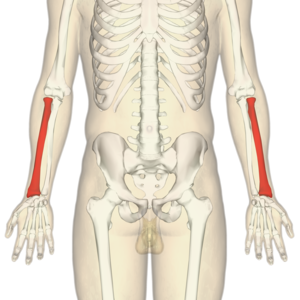Radius
Original Editor
Top Contributors - Abbey Wright, Kim Jackson, Joao Costa, Chrysolite Jyothi Kommu, Amanda Ager and Pacifique Dusabeyezu
Description[edit | edit source]
The radius is one of the two bones that make up the forearm, the other being the ulna. It forms the radio-carpel joint at the wrist and the radio-ulnar joint at the elbow. It is in the lateral forearm when in the anatomical position. It is the smaller of the two bones.
Structure[edit | edit source]
Proximal radius[edit | edit source]
The proximal radius consists of the radial head, neck and tuberosity.
The radial head is cylindrical which articulates with the capitellum of the humerus[1]. The head rotates within the annular ligament to produce supination and pronation of the forearm.[2]
The neck and tuberostiy support the head and provide points of attachments for supinator brevis and biceps bracii.[1]
Radial shaft[edit | edit source]
The shaft of the radius is slightly curved into convex from the body. The majority of the shaft has three borders: anterior, posterior and interosseous.
Distal radius[2][edit | edit source]
The distal radius has five surfaces:
- Lateral - which extends to form the styloid process
- Medial - consists of a concave ulnar notch to articulate with the ulnar head in pronation
- Posterior - convex and contains a prominent ridge called Lister's tubercle
- Anterior - smooth and forms a distinct margin
- Distal articular surface - articulates laterally with scaphoid and medially with lunate
Function[edit | edit source]
The radius' main functions are to provide supination and pronation of the elbow, and all movements of the wrist.
Articulations[edit | edit source]
Elbow[edit | edit source]
Wrist[edit | edit source]
Muscle attachments[edit | edit source]
Clinical relevance[edit | edit source]
Most commonly injured by fracture: fall on outstretched hand (FOOSH) commonly referred to as colles fracture.








